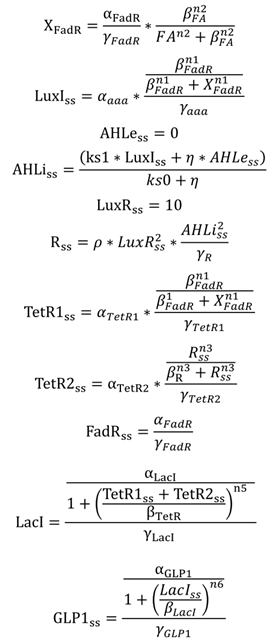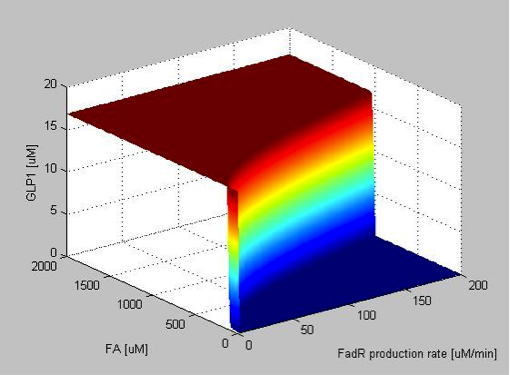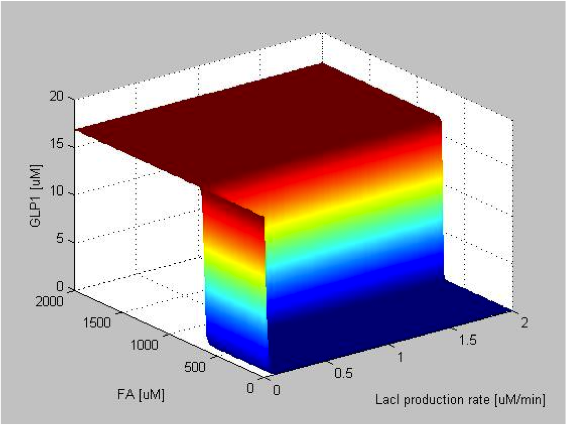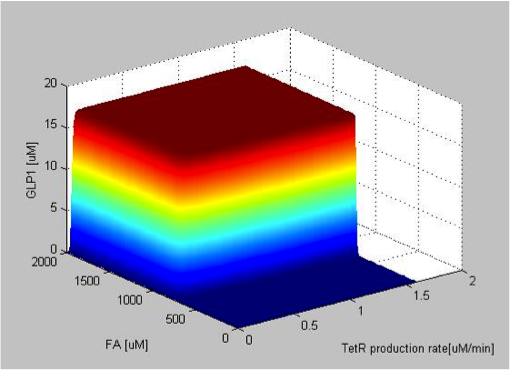Team:NTU-Taida/Modeling/System-Analysis
From 2012.igem.org
System Analysis
Contents |
Overview
System analysis explores extensively into the parameter space by sweeping each parameters for certain range while make the others constant. In this way, we can see the corresponding output response when the value of a specific parameter varies within a certain extent. It provides deep insights into the roles each parameter plays in our single cell model. In one aspect, it examines the robustness of our system. In another aspect, it provides valuable information helping us to determine which parameters should be adjusted in order to achieve our expected circuit response, that is, to tune the threshold of our high-pass filter to the desired level.
Parameter Sweeping
Our system analysis model is an extension of our single cell model. In order to perform the parameter sweeping, we replace the constant values of parameters with a range of values. For simplicity, we focus only on the steady state of our circuit. The steady states of each species are derived using Maple, and are then ported to Matlab for simulation. The input of our system, the fatty acid, is also included as our sweeping parameters in each sweep, enabling us to observe the threshold of the filter in our circuit. The combined input and parameter sweeping gives us a 3-dimensional graph, with x-axis, y-axis and z-axis being the parameter under analysis, the input fatty acid concentration and the output GLP1 concentration, respectively.
Results
The following figures show the results of the sweeping of protein production rates, repression coefficients and degradation rates.
System Robustness
- alpha_FadR
When the FadR production rate is zero, there is no FadR existing in the cell, which means that TetR is not repressed. So that GLP-1 remains high at this value regardless of FA concentration. After the FadR production rate goes above a threshold not far from 0, sharp transitions between the maximum level of GLP1 and zero appears, as shown by the rainbow-color, nearly vertical plane. The FA value of the intersection between the vertical plane and the ground horizontal plane is the value of FA that triggers the system to produce GLP1, and therefore can represent the filtering threshold of our circuit. FadR production rate affects the value of the threshold dramatically as can be seen by the shifts of the intersection between the vertical plane and horizontal plane rapidly to higher FA values as the production rate increases. The result can be more clearly seen when plotting the y-z cut plane with different alpha_ FadR on the same two-dimensional figure, as shown in Figure 9 in the next section. - alpha_LacI
When the LacI production rate is zero, there is no LacI present in the cell, which means that GLP-1 is not repressed. So that GLP-1 remains high at this value regardless of FA concentration. After the LacI production rate goes above a threshold very close to 0, sharp transitions between the maximum level of GLP1 and zero appears. We can observe that above the threshold the GLP-1 response is very robust to the change in LacI production rate, maintaining the constant maximum GLP1 level as the LacI production rate varies. LacI production rate has no significant effect on the value of the threshold as can be seen by the almost constant FA value of the intersections between the vertical plane and horizontal plane as the production rate increases. The result can be more clearly seen in the corresponding 2D figure. - alpha_TetR
When the TetR production rate is zero, there is no TetR present in the cell, which means that LacI is not repressed so it is free to block GLP-1 production. Therefore, there are no GLP1 expressed despite of the high FA input. As soon as the production rate becomes non-zero, the production of GLP1 appears abruptly and with sharp threshold. The maximum level of GLP1 expression stays at a constant value, verifying the robustness of our system. It can be seen that the threshold of FA filter varies little with varying TetR production rate, with smaller TetR production rate resulting in slightly higher threshold.
 "
"





